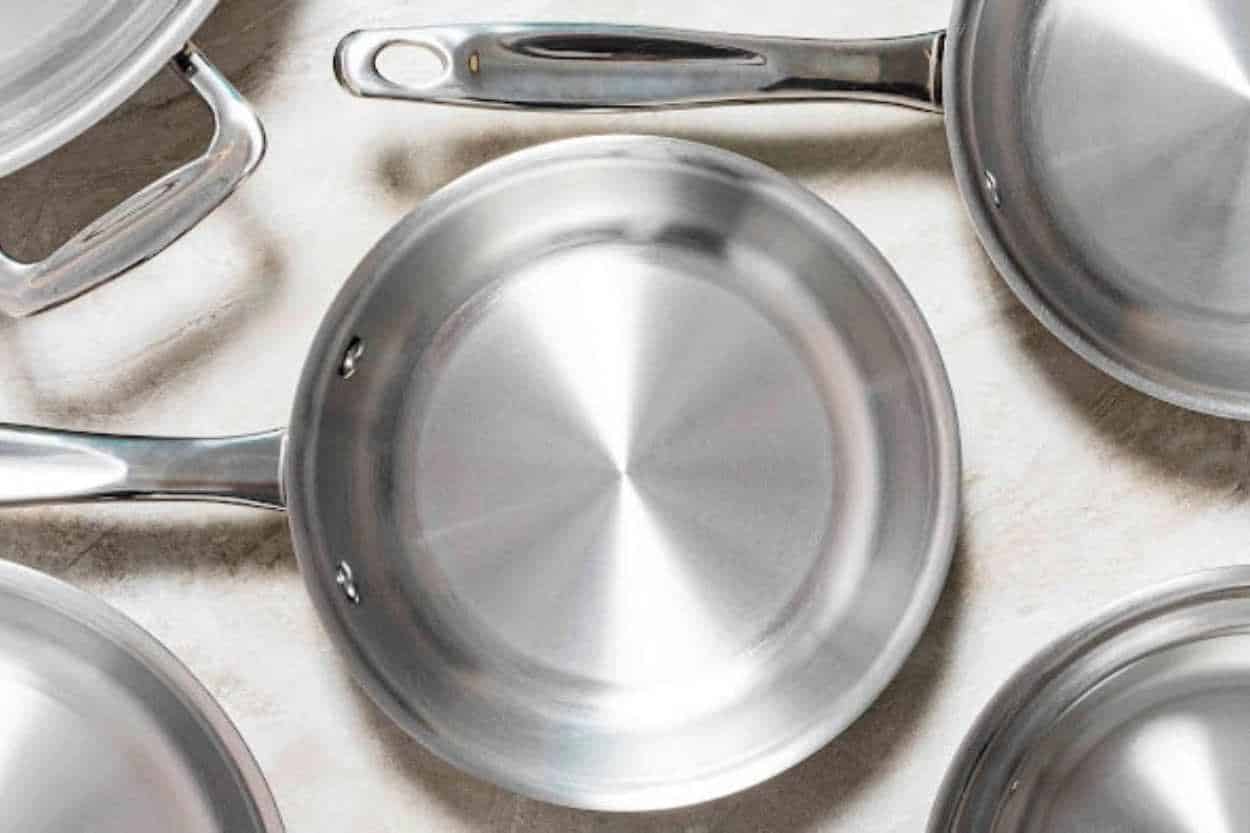You’ve likely come across a Made In and Misen pan while looking for professional-grade cookware. Both brands indeed make high-quality pans/skillets that are decently priced.
But, how can you distinguish the two brands’ skillets when it comes to value? In this comprehensive guide, we’ll look deeper at the pros and cons of Made In vs. Misen pans. Let’s dive into the details.
General Overview of Made In vs. Misen Pans
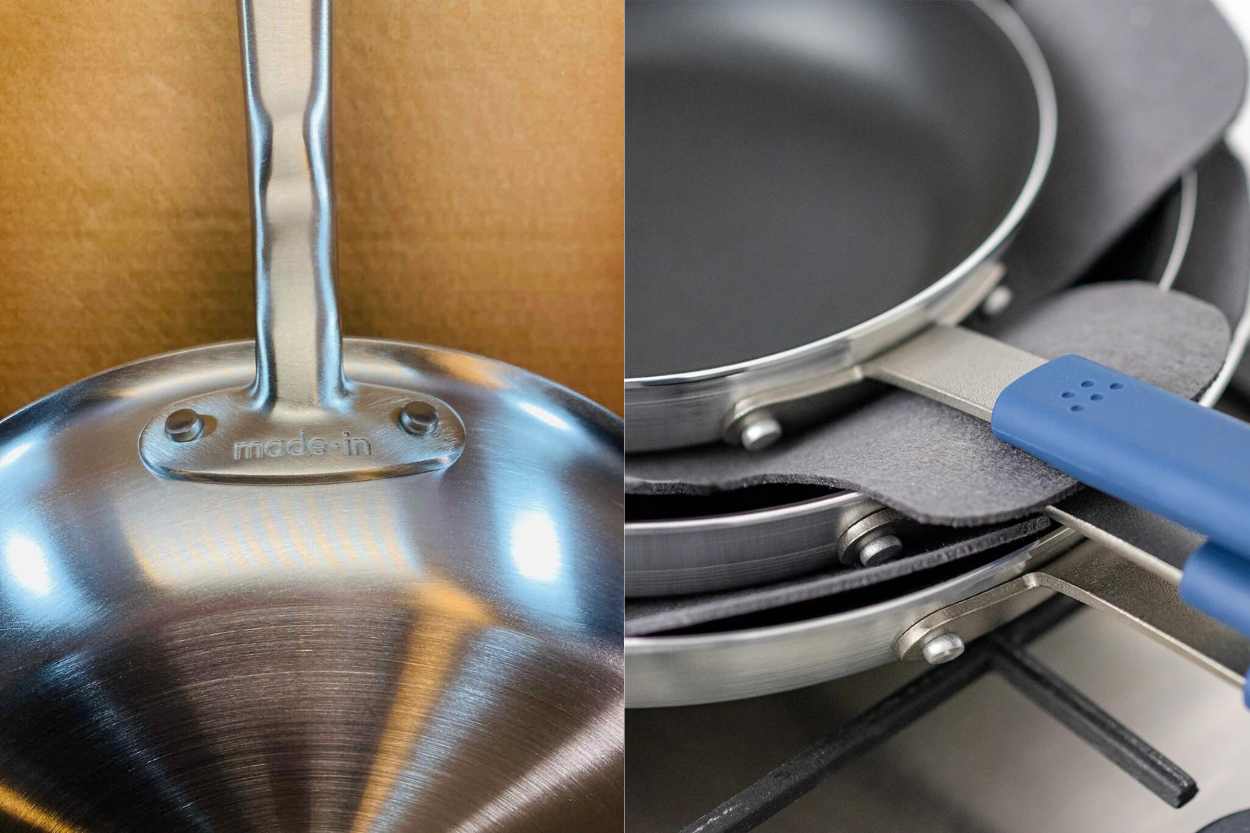
Made In and Misen both aim to create quality cookware at fair prices.
These brands cut out the middleman by selling their products online on their websites and on Amazon. They offer a better value than most traditional retail brands. We call this sales model direct-to-consumer (abbreviated DTC or D2C).
Here’s a side-by-side table for an assortment of pans from Made in and Misen that are similar in their build:
| Made In | Misen | Common features |
| Stainless clad | Stainless skillet | 5-ply construction, optimized for fast and even heating. Made In is normally thicker than Misen. |
| Non-stick | Non-stick | 100% non-toxic and made without PFOA for the non-stick layers. |
| Enameled cast iron | Enameled cast iron braiser | Superior heat retention, easy-to-clean surface, and no need to season. |
| Carbon steel | Carbon steel | Like cast iron but lighter, with faster heating, non-stick with seasoning, and virtually indestructible. |
| Copper | Only offered by Made In here. An excellent conductor of heat. Elegant, expensive, heavy, and reactive material. |
In general, all the varieties of pans in the table above come in sizes 8”, 10”, and 12”.
Before diving into the specifics of each pan, let’s look at what the two brands stand for.
Brand Values and Target Audience
Made In was started in 2016 by two close friends, Jake Kalick and Chip Malt. Jake was into e-commerce, while Chip’s family had a long history in the kitchenware industry.
Put two and two together, and you get a multi-award-winning team for Made In—quality cutlery delivered to your doorstep.
Made In sources its materials from renowned manufacturers all over the world. However, they are by and large referred to as an American company. So, if you prefer a brand not primarily associated with manufacturing in China, Made In is a good option.
Chef Omar Rada started Misen in 2015. His friends’ frustration with getting quality kitchenware at a sensible price inspired him to open shop. Omar began a Kickstarter campaign, raising over $1.2 million from 13,000 backers—an amazing feat.
Misen grew in popularity so much because of its aggressive online campaigns. You’ve probably been bombarded with a barrage of ads from them on your social media.
One downside you may say about Misen products is that they are made in China, but then again, what isn’t? Even chef Gordon Ramsay’s Hex Clad cookware (all hype) is also made in China, and no one’s complaining.
How Made In and Misen Pans Compare
Here’s how Made In and Misen pan varieties differ from each other when it comes to build:
Stainless Steel
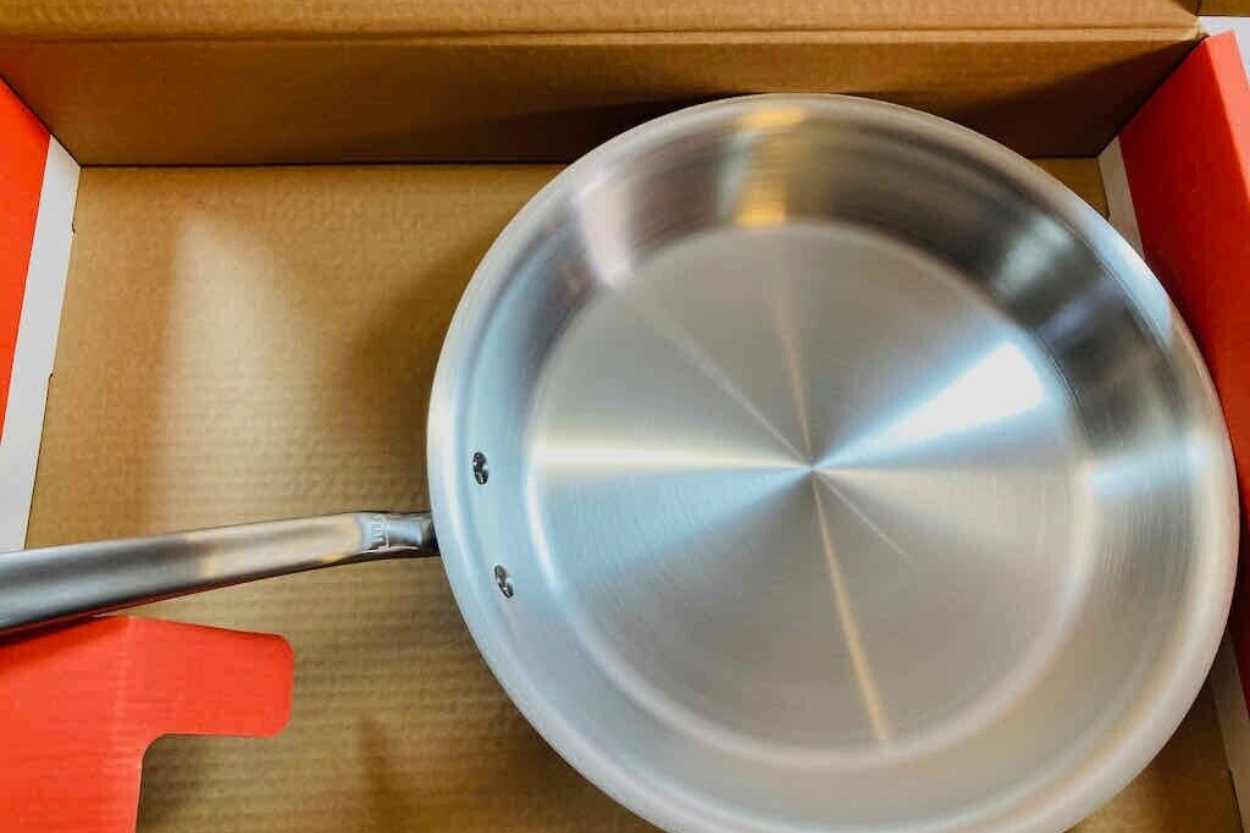
Made In and Misen stainless steel pans are built with a 5-ply construction. 3 layers of aluminum are pressed between two exterior stainless steel panels.
The aluminum alloy ensures an even dispersion of heat. The outer layer of both pans makes them compatible with induction cooktops.
Made In stainless steel variants are oven safe at up to 800 ℉. Misen skillets are rated at up to 500 ℉.
Another difference is the thickness. For example, Made In’s 10-inch frying pan is 2.7 mm thick, while Misen’s 3 mm. As a result, Misen pans are heavier, coming in at 2.9 pounds and 2.25 pounds for Made In. That’s almost 30% heavier.
A thicker pan spreads and retains heat better, and is presumably more durable than a thinner one. For all these reasons, Misen wins here. And, don’t forget, you’re paying less for it.
Non-Stick
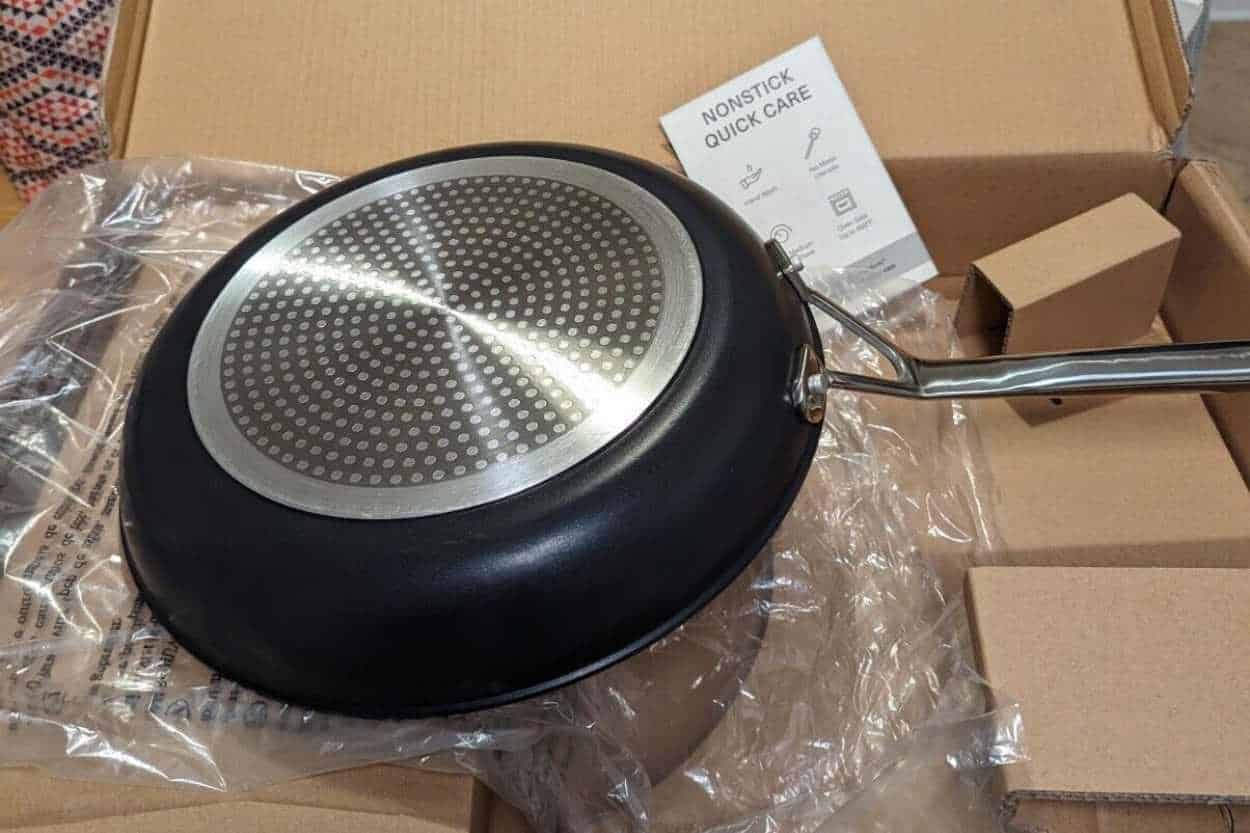
Made In and Misen non-stick pans use a coating made of PTFE (polytetrafluoroethylene), a polymer with a low friction coefficient. What sets this coat apart from other traditional non-stick pans in the market is that it’s PFOA-free.
PFOA is a harmful chemical. Alas, PTFE degrades faster, especially if exposed to high temperatures or abrasive materials.
Made In uses 4 layers of coating, while Misen uses 3 layers of non-stick. However, we did not experience any substantial difference in the pans’ wear and tear. Either way, the coating will wear out. That’s the nature of non-stick coatings.
Carbon Steel
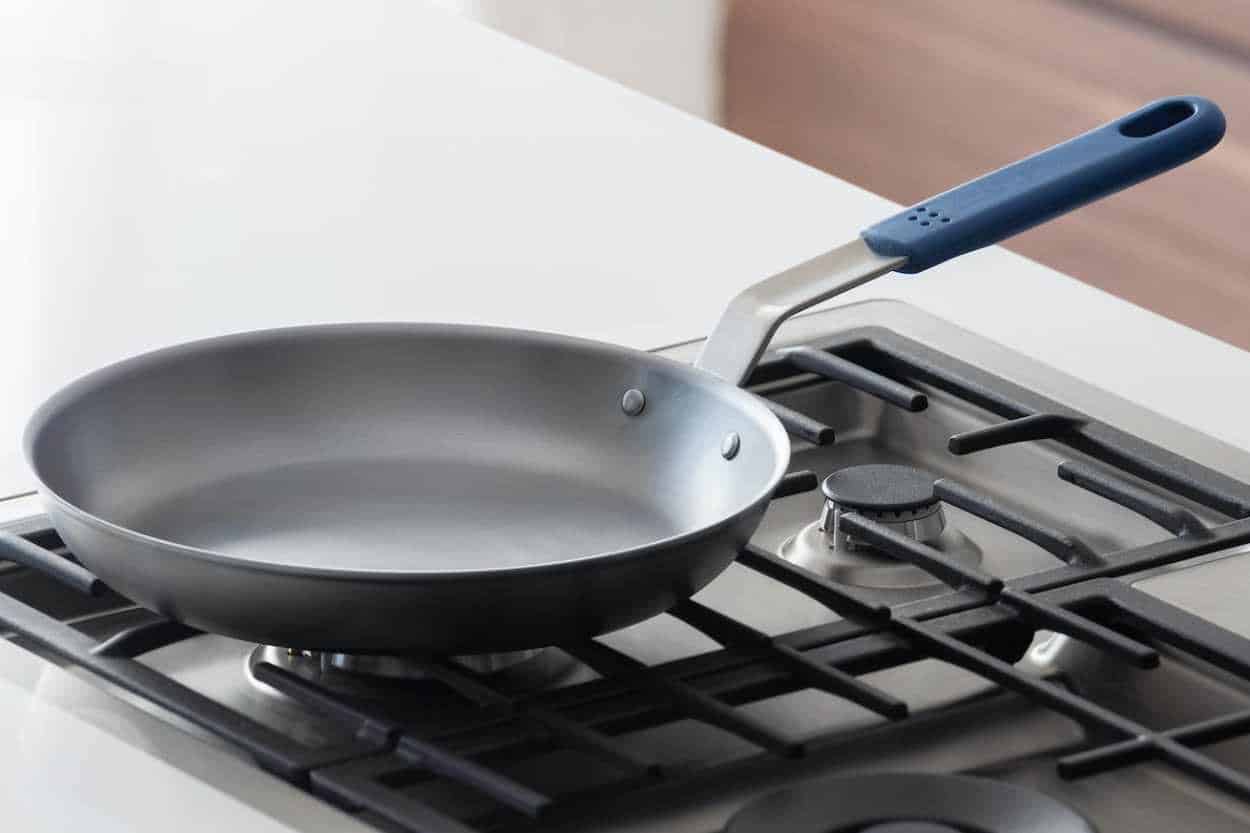
These pans are made of blue carbon steel. This is a type of metal treated with heat and oil to form a protective layer of iron oxide. Carbon steel pans are light, pick up heat fast, and are designed to last a lifetime.
Made In carbon steel pans are 2 mm thick, while Misen’s 3 mm. We hate to sound like a broken record, but a thicker pan’s better for cooking, especially over high heat. So, Misen wins here as well. And, it’s cheaper.
A not-so-significant difference between the two carbon steel pans is the type of pre-seasoning used. Made In uses grape seed oil, while Misen uses soybean oil.
Enameled Cast Iron
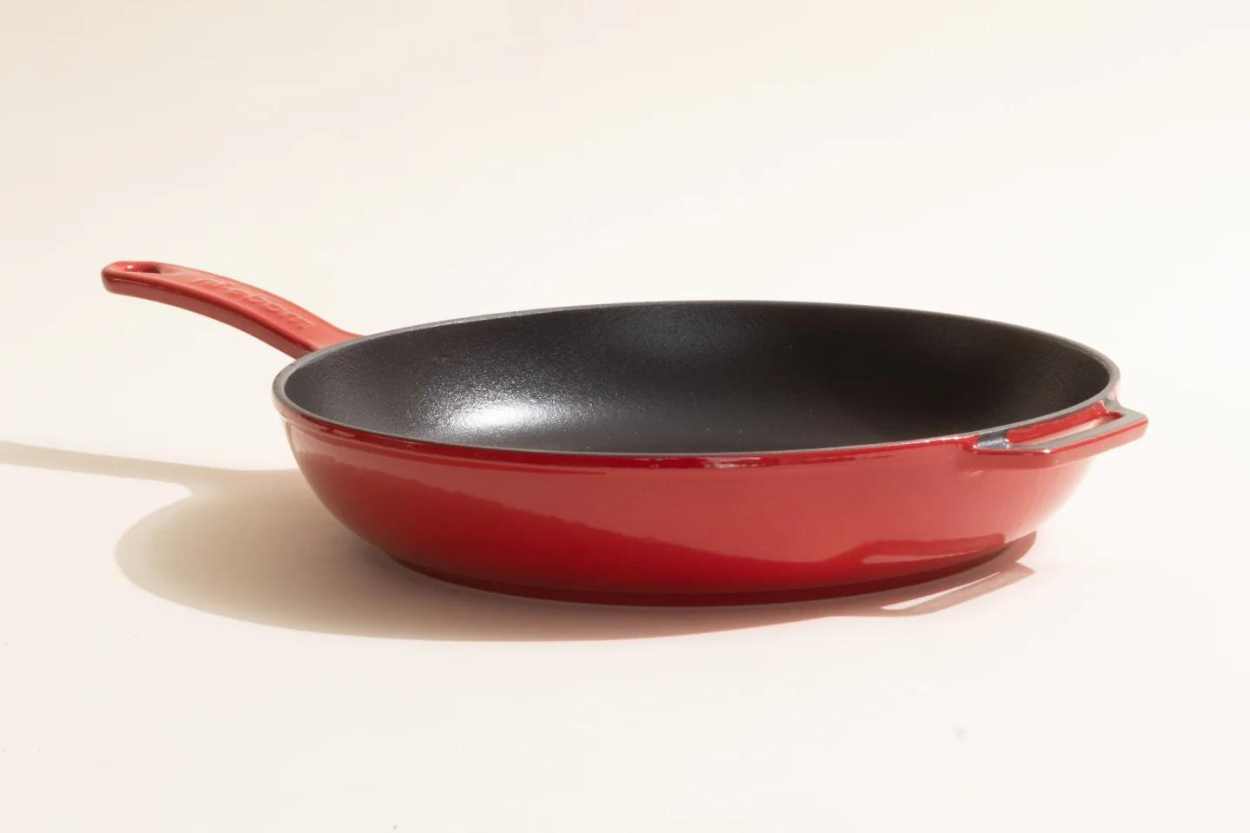
Made In fabricates its enameled cast iron products in France. On the other hand, Misen makes theirs in China—this might lead to raised eyebrows for those questioning their quality.
Remember, Enameled cast iron is pricey and only the best will do—it’s only right that you get a premium device. And, Made In cast iron products are not that much more expensive compared to Misen’s.
Both brands’ enameled cast iron cookware are: easy to clean, can withstand high temperatures, retains heat well, and does not need seasoning like regular cast iron.
Design and Ergonomics
Made In pans are beautiful and modern looking. This brand offers more variety not only in terms of products but design. They even have different color versions in some of their ware.
Misen pans have a retro look with a polished exterior and straight rim. Their rims are raised a bit more than Made In’s, making them better when tossing.
Weight
Misen pans are usually thicker than Made-In’s, which makes them heavier. It’s all a matter of preference with the one you go for here.
Go for the heavy Misen pan because it’ll feel sturdy and solid. Or, you like Made In because it’s easier to lift and move around as you cook.
Handle Comfort
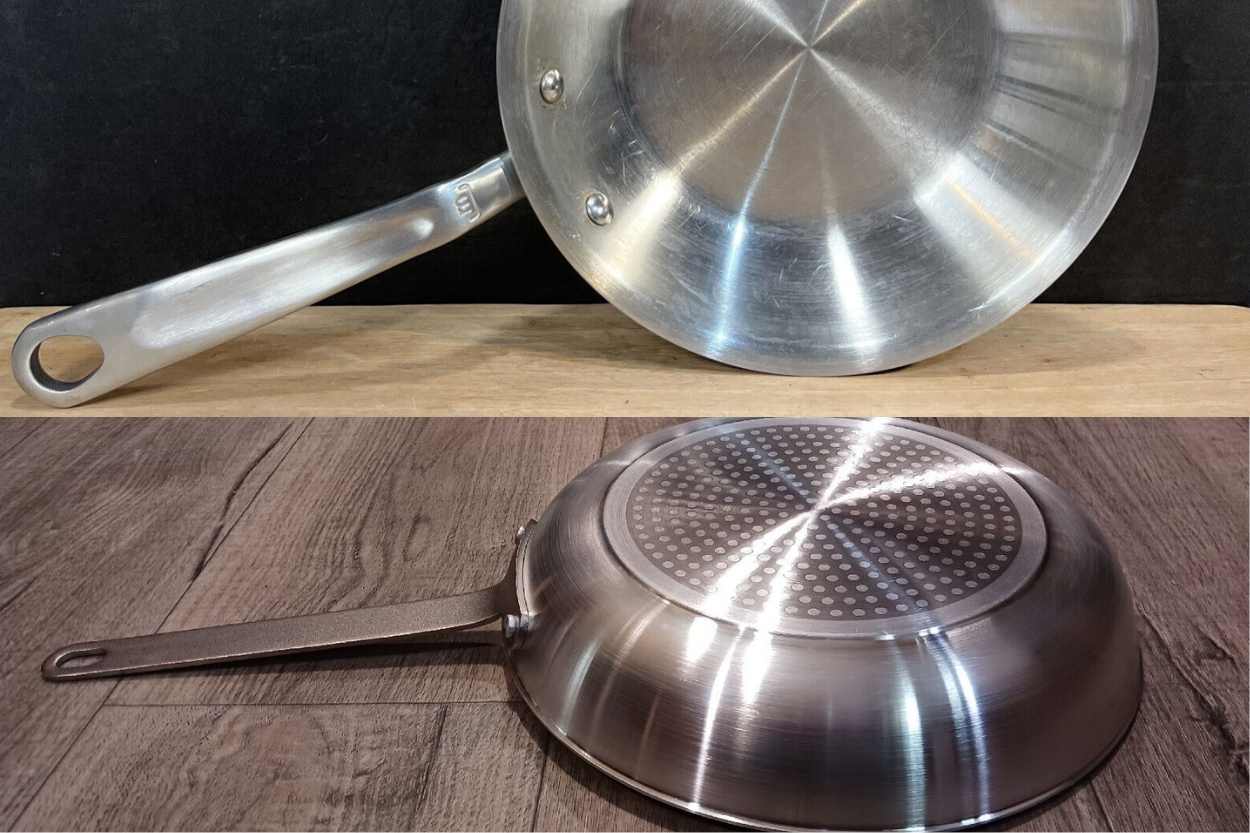
Both brands have a modern design in their handles and they ensure utmost user comfort.
They use a stainless steel handle riveted to their pans for durability and safety. You’ll hardly ever need to use mittens when handling either type of pan because they don’t heat up.
Made In products normally have a brushed stainless steel handle that doesn’t pick up fingerprints or smudges. Their handles also have a curved shape that makes it easy to handle the pan.
Misen handles also have a straight shape that ensures a secure grip. This design also makes it easy to fit the pan in narrower ovens. One not-so-significant difference we found is that Made In handles are marginally longer compared to Misen’s.
Cleaning and Maintenance
Misen used a removable silicone handle in previous designs of their pans. However, this style has been phased out over the years in newer models.
Both brands claim their pans are dishwasher safe. However, we recommend hand washing them with mild soap and warm water for longevity and to preserve their shine.
Cooking Results/ Performance
To gauge the results of Made In and Misen pans, we’ll highlight independent tests done by renowned chefs.
In the Cook Culture YouTube channel, the host compared a new Misen carbon steel pan to Made In’s. Despite being new and having fewer seasoning sessions, it was clear that Misen’s pan performed far better than Made In’s.
Test searing meat on gas shows that both brands’ skillets produced a nice crust and juicy interior on the steak. However, Misen’s had a more consistent sear. Based on these tests, Misen pans are better at heat retention, responsiveness, and durability.
Even though Made In pans heat up faster compared to Misen’s due to being thinner, the difference is negligible. However, in the important aspect of heat retention, Misen pans win.
You can also see another video by cooking instructor Helen Rennie. She is VERY critical of Made In’s carbon steel pan from minute 5:40. In the clip, you can see how they cook so poorly. The pan’s too thin, and it holds seasoning awfully.
On the other hand, Misen pans spread heat more evenly than Made In’s.
Cost and Buying Options
Both Made In and Misen pans are competitively priced compared to other brands of similar quality. And, if you’re in the US, you get free shipping to boot. That’s not all, both brands offer a lifetime guarantee against manufacturer defects and provide a long trial period.
Here’s a head-to-head comparison table of Made In and Misen pans:
| Features | Made In | Misen |
| Design | Tie | Tie |
| Heat conduction | Win | |
| Heat retention | Win | |
| Oven safety | Win | |
| Stove Compatibility | Tie | Tie |
| Aesthetics | Win | |
| Price | Win |
When it comes to price, Misen wins hands down. Here’s a table of select similar products, their prices, and the percentage difference.
| Brand | Made in | Misen |
| 12” non-stick | $149 | $75 |
| 10” non-stick | $129 | $65 |
| 12” carbon steel | $129 | $90 |
| 8” carbon steel | $79 | $70 |
| 8” stainless steel | $99 | $65 |
| 10” stainless steel | $109 | $75 |
From the table above, you can see there’s a substantial difference in prices, more so for non-stick than carbon steel products. And, the crux of the matter is, Misen wins in most categories of functionality than Made In.
To save even more bucks on your purchase, subscribe to both brands’ newsletters and be on the lookout for discounts on their websites. Sometimes, you’ll find bumper deals that’ll leave you in awe.
Pros and Cons
Here is a quick summary of the pros and cons of Made In and Misen pans:
Made In pans summary:
| Pros | Cons |
| High-quality build, modern design, and more varieties | Prone to bending, scratching, and food getting stuck to pans |
| Heats up fast with okay temperature control | Uneven distribution of heat due to thinner surface |
| Dishwasher-safe, oven-safe, and broiler-safe | Lackluster customer care |
| Competitively priced and free shipping | |
| Lifetime warranty and 45-day trial period | |
| One-year warranty on non-stick pans |
Misen pans summary:
| Pros | Cons |
| Modern design with polished straight rims | Not made in the US |
| Durable, heavy, and heats evenly | Slow heating |
| Dishwasher-safe, oven-safe, and broiler-safe | No warranty on non-stick pans |
| Free shipping in the US | Poor customer service and return policy |
| Lifetime warranty and 60-day trial period |
Conclusion
Made In and Misen pans are excellent choices for anyone desiring to upgrade their kitchenware. If you are willing to dish out more dough and prefer a lighter pan that’s not made in China, go for Made In.
We feel Misen’s better when it comes to functionality, and they cost even less than Made In. Other factors you might consider are aesthetics and ergonomics, which is a matter of your heart’s desires.
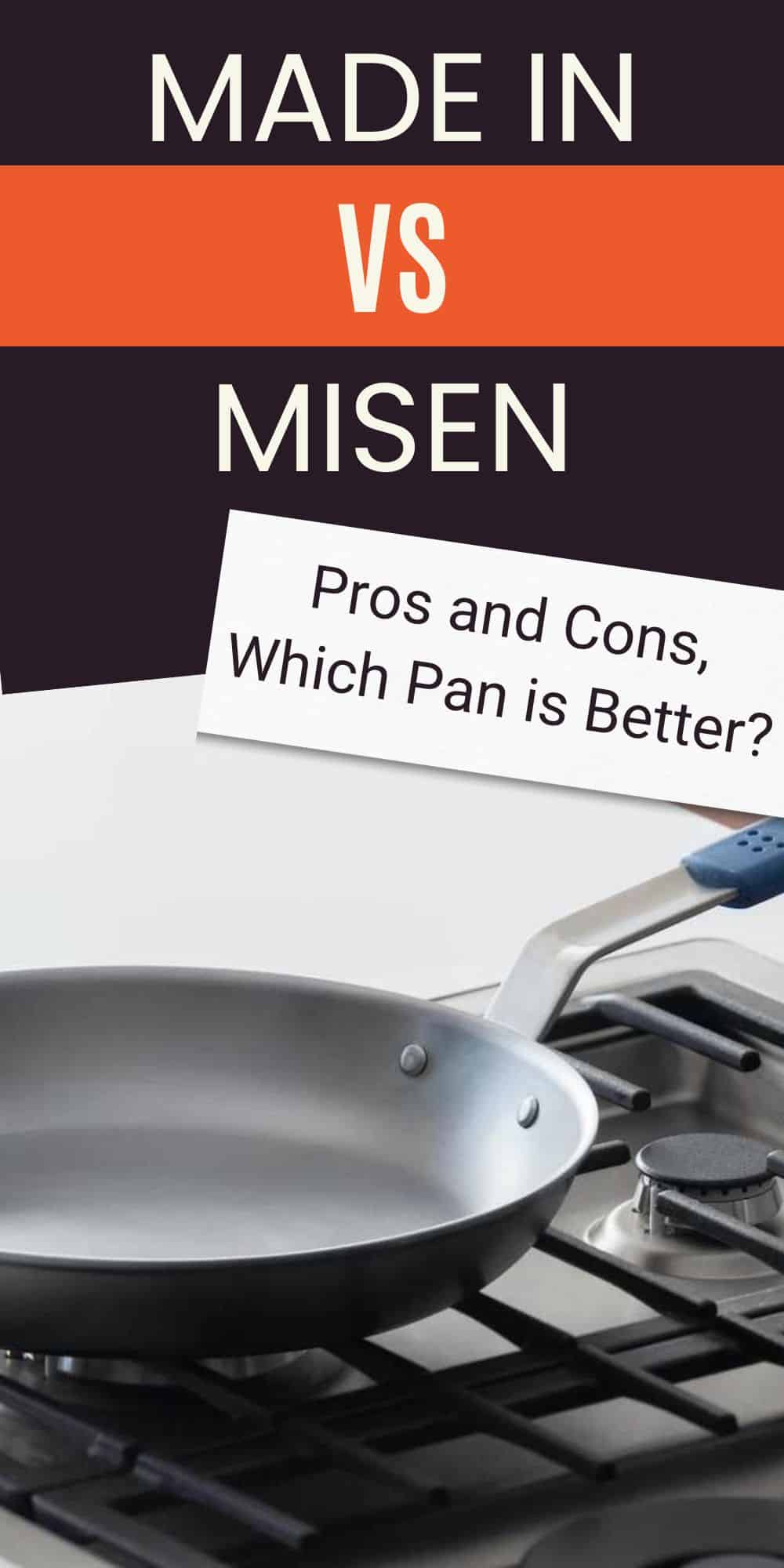

Michael Johnson is the founder of Pan Mastery, Inspired by his blacksmith grandfather’s legacy has a deep appreciation for hand-crafted pots and pans, he provides invaluable guides, reviews, and recipes to enhance your culinary journey.

